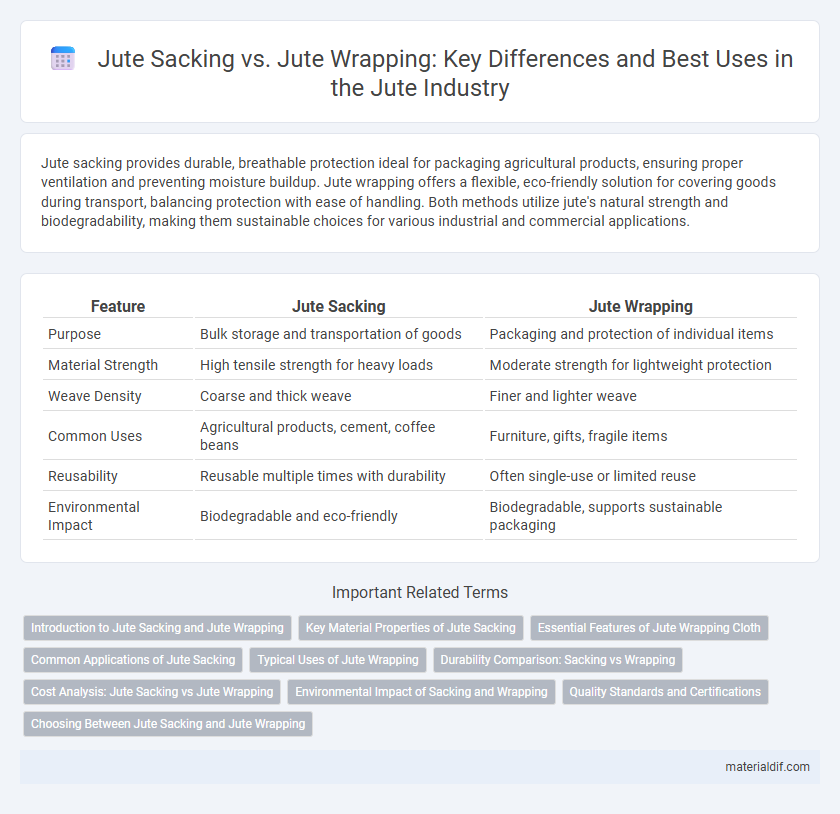Jute sacking provides durable, breathable protection ideal for packaging agricultural products, ensuring proper ventilation and preventing moisture buildup. Jute wrapping offers a flexible, eco-friendly solution for covering goods during transport, balancing protection with ease of handling. Both methods utilize jute's natural strength and biodegradability, making them sustainable choices for various industrial and commercial applications.
Table of Comparison
| Feature | Jute Sacking | Jute Wrapping |
|---|---|---|
| Purpose | Bulk storage and transportation of goods | Packaging and protection of individual items |
| Material Strength | High tensile strength for heavy loads | Moderate strength for lightweight protection |
| Weave Density | Coarse and thick weave | Finer and lighter weave |
| Common Uses | Agricultural products, cement, coffee beans | Furniture, gifts, fragile items |
| Reusability | Reusable multiple times with durability | Often single-use or limited reuse |
| Environmental Impact | Biodegradable and eco-friendly | Biodegradable, supports sustainable packaging |
Introduction to Jute Sacking and Jute Wrapping
Jute sacking refers to the production of durable bags and sacks made from natural jute fibers, primarily used for packaging agricultural products like potatoes, coffee beans, and grains due to their breathability and strength. Jute wrapping involves using thin jute fabric sheets or rolls to wrap and protect items, offering eco-friendly and biodegradable alternatives to plastic wraps. Both applications utilize jute's natural properties, but sacking emphasizes heavy-duty containment while wrapping focuses on flexible protection.
Key Material Properties of Jute Sacking
Jute sacking is characterized by its high tensile strength, durability, and breathability, making it ideal for heavy-duty packaging and transportation of agricultural products. The coarse weave and robust fibers provide excellent resistance to abrasion and environmental stress, ensuring protection during handling and storage. Unlike jute wrapping, jute sacking offers superior load-bearing capacity and longevity due to its thicker material and reinforced construction.
Essential Features of Jute Wrapping Cloth
Jute wrapping cloth is characterized by its coarse texture, high tensile strength, and excellent breathability, making it ideal for packaging fresh produce and agricultural products. Unlike jute sacking, which is primarily used for heavy-duty storage and transport, jute wrapping cloth offers a flexible, lightweight solution that protects goods while allowing air circulation to prevent moisture buildup. This essential feature set enhances product preservation and reduces the risk of spoilage during handling and transit.
Common Applications of Jute Sacking
Jute sacking is primarily used for packaging agricultural products such as potatoes, onions, and coffee beans due to its durability and breathability, allowing proper air circulation and moisture control. It is also widely employed in construction for sandbags, erosion control, and transporting bulk goods. Jute wrapping, by contrast, is mainly utilized for protective covering and cushioning in shipping fragile items, offering flexibility but less structural strength.
Typical Uses of Jute Wrapping
Jute wrapping is typically used for packaging agricultural produce, such as fruits, vegetables, and coffee beans, due to its breathability and moisture control properties. It serves as an eco-friendly alternative to plastic, helping to maintain product freshness during transportation and storage. Its natural fibers also provide cushioning, reducing damage to delicate items in transit.
Durability Comparison: Sacking vs Wrapping
Jute sacking offers superior durability compared to jute wrapping due to its thicker weave and reinforced stitching, making it ideal for heavy-duty storage and transportation. In contrast, jute wrapping features a lighter, more flexible weave suited for temporary protection and delicate surface covering. The robust nature of jute sacking ensures longer lifespan under harsh environmental conditions, while jute wrapping prioritizes breathability and ease of use.
Cost Analysis: Jute Sacking vs Jute Wrapping
Jute sacking typically incurs higher costs due to its thicker, more durable fabric designed for heavy-duty applications, whereas jute wrapping is more cost-effective for lightweight packaging needs. The price difference reflects material usage, with sacking requiring more raw jute fiber and labor-intensive weaving compared to the simpler construction of wrapping sheets. Businesses evaluating packaging expenses often favor jute wrapping for budget-sensitive projects, while jute sacking remains essential where strength and protection justify the premium.
Environmental Impact of Sacking and Wrapping
Jute sacking significantly reduces plastic waste due to its biodegradability and compostable nature, making it an eco-friendly alternative for packaging agricultural products. In contrast, jute wrapping minimizes resource consumption by using thinner, flexible material that requires less jute fiber, leading to a lower carbon footprint during production. Both jute sacking and wrapping support sustainable agriculture by enhancing soil health through natural decomposition, reducing landfill burden compared to synthetic materials.
Quality Standards and Certifications
Jute sacking typically adheres to stringent quality standards such as ISO 9001 certification, ensuring durability, tensile strength, and resistance to environmental factors, making it ideal for heavy-duty packaging. Jute wrapping, while also maintaining high quality, often focuses on flexibility and aesthetic appeal, meeting certifications like OEKO-TEX Standard 100 for eco-friendliness and safety in direct contact with products. Both applications underscore the importance of adherence to international quality benchmarks to guarantee performance and sustainability in agricultural and industrial use.
Choosing Between Jute Sacking and Jute Wrapping
Choosing between jute sacking and jute wrapping depends on the intended application and durability requirements. Jute sacking offers robust protection and breathability, making it ideal for heavy goods and long-term storage. Jute wrapping, by contrast, provides a lightweight, flexible solution suited for decorative purposes or short-term packaging, emphasizing environmental sustainability.
Jute Sacking vs Jute Wrapping Infographic

 materialdif.com
materialdif.com